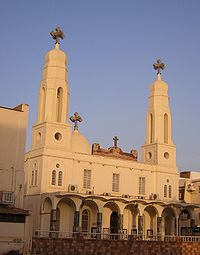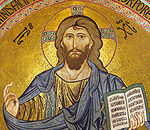- Christianity in Sudan
-
Christianity has a long history in Sudan, starting from Roman times.
Contents
History
Christianity reached what is now northern Sudan, then called Nubia, by about the end of the first century after Christ.
It greatly developed under the influence of the Eastern Roman Empire.[1] Indeed, Byzantine architecture influenced most of the Christian churches in lower Nubia [2]
The Roman Emperor Justinian I made Nubia a stronghold of Christianity during the Middle Ages.[3] By 580 AD, Christianity had become the official religion of the northern Sudan, centered around the Faras cathedral.
It largely disappeared following later Islamic conquests, but only after a long lasting struggle that went on for eight centuries.
During the 19th century, British missionaries re-introduced the Christian faith into South Sudan.
Sudan, the largest land-mass country in Africa, has a population of nearly 40 million people with the heaviest concentration in the north: an estimated 16% are Christians while Muslims make up 62% and those who practice traditional religions 22%.[citation needed] Taking Southern Sudan apart from the north the numbers shift to almost 50% Christian in this southern area.[citation needed]
The majority of Christians in Sudan are adherents of either the Roman Catholic or Anglican churches (represented by the Episcopal Church of the Sudan) but there are several other small denominations represented there including:[citation needed]- Apostolic Church
- New Apostolic
- Coptic Church
- Coptic Orthodox Church
- Ethiopian Orthodox Church
- Eritrean Church
- Greek Orthodox Church
- Presbyterian Church of the Sudan
- Seventh Day Adventist Church
- Sudan Presbyterian Evangelical Church
- Sudan Pentecostal Church
- Sudan Interior Church
- Africa Inland Church
- Sudan Church of Christ
Roman Catholic missionaries began work in Sudan in 1842; both the Anglicans and the American Presbyterians began in Sudan in 1899. The Anglicans through the Church Missionary Society had their base in Omdurman, while the Presbyterians began in Khartoum but developed ministry both in the north and in the south. The Sudan Interior Mission began working in the country in 1937. The Africa Inland Mission launched the Africa Inland Church in 1949. In 1964 all foreign missionaries were made to leave southern Sudan because of the civil war. A few groups maintained missionaries in the north. The Sudan Pentecostal Church, which has grown significantly in the south, was started later by the Swedish.
There are now about 2,009,374 Sudanese practicing Roman Catholicism, mainly in the south of the country (5% of the population are devout Roman Catholics).[citation needed] The patron saint of the Sudan is the former slave Saint Josephine Bakhita, canonized in 2000.
There are nine catholic dioceses including two archdioceses in modern Sudan,[4] with five Cathedrals.[5]
About 100,000 people or 0.25% of the population belong to various Protestant denominations in northern Sudan. Catholicism is practised by some thousand followers north of Sudan's capital.
Christianity by Country
North AmericaSouth AmericaOceaniaNotes
- ^ Christianity in Nubia
- ^ Photos of Christian Nubia churches
- ^ Christian Nubia and the Eastern Roman Empire
- ^ Sudanese Dioceses and Archdiocese
- ^ Cathedrals in the Republic of Sudan
Bibliography
- Jakobielski, S. Christian Nubia at the Height of its Civilization (Chapter 8). UNESCO. University of California Press. San Francisco, 1992 ISBN 9780520066984
- Maria Alloisio. Bakhita. Editrice La Scuola. Brescia, 1970.
See also
- Early history of Sudan
- Nubia
- Romans in Nubia
- Josephine Bakhita
Christianity in Africa Sovereign
states- Algeria
- Angola
- Benin
- Botswana
- Burkina Faso
- Burundi
- Cameroon
- Cape Verde
- Central African Republic
- Chad
- Comoros
- Democratic Republic of the Congo
- Republic of the Congo
- Côte d'Ivoire (Ivory Coast)
- Djibouti
- Egypt
- Equatorial Guinea
- Eritrea
- Ethiopia
- Gabon
- The Gambia
- Ghana
- Guinea
- Guinea-Bissau
- Kenya
- Lesotho
- Liberia
- Libya
- Madagascar
- Malawi
- Mali
- Mauritania
- Mauritius
- Morocco
- Mozambique
- Namibia
- Niger
- Nigeria
- Rwanda
- São Tomé and Príncipe
- Senegal
- Seychelles
- Sierra Leone
- Somalia
- South Africa
- South Sudan
- Sudan
- Swaziland
- Tanzania
- Togo
- Tunisia
- Uganda
- Zambia
- Zimbabwe
States with limited
recognition- Sahrawi Arab Democratic Republic
- Somaliland
Dependencies and
other territories- Canary Islands / Ceuta / Melilla / Plazas de soberanía (Spain)
- Madeira (Portugal)
- Mayotte / Réunion (France)
- Saint Helena / Ascension Island / Tristan da Cunha (United Kingdom)
- Western Sahara
Wikimedia Foundation. 2010.



